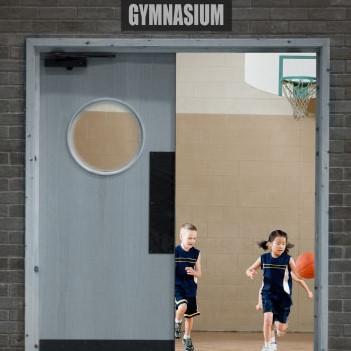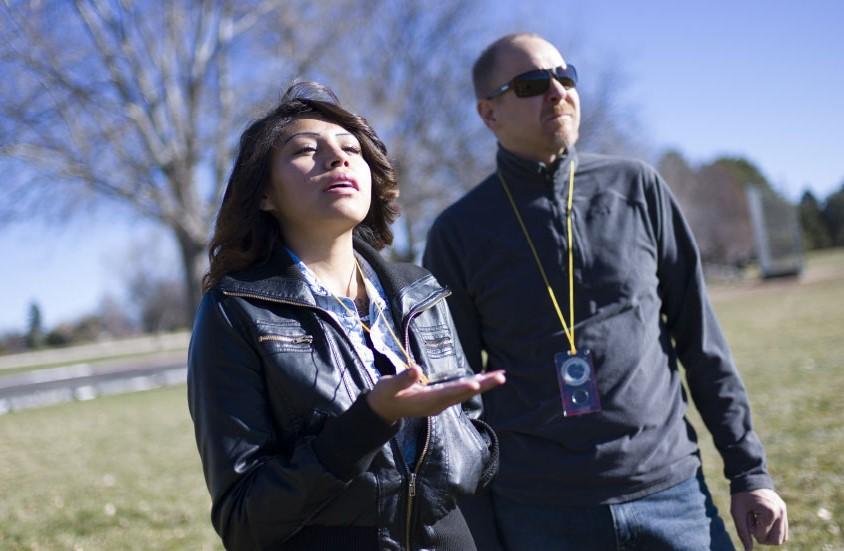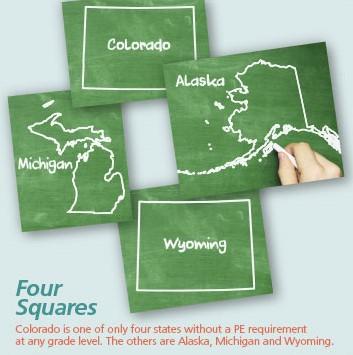This is how physical education gets done in Colorado, but only if you're very motivated.
Find a dingy old storage room.
Get the shop class to tear down the dusty storage cages and rebuild them elsewhere.
Volunteer some expert community members to lay in a new rubber floor.
Apply for grants to fill the room with shiny new exercise equipment.
Encourage a fitness instructor who just moved to your tiny town to host cut-rate classes in the new space.
Keep showing up at 6 in the morning for Pilates, until things catch on.
And there you have it. Simple, right?
If you can improve PE and involve more kids in Hayden, Colo., pop. 1,634, can you do it anywhere?

Only when community effort is backed up by muscular public policy.
The Hayden School District backs up its community grit with rigorous guidelines: Elementary students get an hour of PE every day; middle school students go five days a week; and high schoolers need two physical activity credits to graduate.
Elsewhere in Colorado, though, PE success stories are as random as a game of playground tag. Statewide mandates on how much physical activity students receive are weak and unenforced, according to recent surveys and a comparison to best practices elsewhere. While some districts, from tiny Hayden to giant Denver, have taken bold steps forward, other districts like Aurora have actually retreated on PE instruction and time.
Meanwhile the impetus to do something better for Colorado students grows with every new report on obesity, diabetes and people reaching young adulthood already sick and tired. Nearly 27 percent of Colorado children ages 2 to 14 are overweight or obese, reflecting a national trend. Nationwide, the portion of obese children – the most worrisome measure, indicating serious health issues – rose from 7 percent in 1980 to 18 percent in 2010.
A recent national study found one in four U.S. adolescents to be diabetic or prediabetic. If those unwell students grow into diabetic adults, the medical costs will be staggering: $8.3 billion in Colorado by 2030, according to the Colorado Health Institute.
The National Association for Sport and Physical Education recommends 150 minutes a week of PE instruction time in elementary years, and 225 minutes a week for middle and high school students.
A few states, like Illinois and New Mexico, mandate PE every year, from kindergarten to 12th grade. Thirteen states – Colorado is not among them – require collection of body mass index for all students.
Colorado schools are on their own with PE because state standards are weak, with no supervisory or enforcement teeth. And the last effort to make things more rigorous statewide was undercut to the point of practical irrelevance.
A state law, H.B. 1069, sets a target of 600 minutes of physical activity each month. But it allows schools to include recess time and some field trips where students spend time walking. And "allows" is the wrong word – the target is not enforced, nor is there even a mandate to collect and report information on what PE activities schools are doing.
That minimal effort at a statewide standard was a disappointing compromise for many health advocates in 2011. They had started with a legislative draft carrying far more teeth, but ran into deep opposition from school board executives and legislators favoring home rule for cities and school districts.
By the time opponents were done with rewrites, the 2011 law didn't even name a state agency with responsibility to follow up or report on the targets in later years. A 2013 I-News Network survey of the state's 10 largest school districts, comprising nearly 900,000 students, found no changes as a result of the 2011 bill and many schools using questionable fillers like field trip time to meet the standard.
The survey called the landscape "exactly the same for students across the state as it [was] before the law was passed."
The state Department of Education does not take a position on the effectiveness of that bill, or whether PE standards should include more mandates.
What the state says it is doing is finishing up an effort to help PE leaders write curriculum that meets best practices for instruction and learning, and to disseminate that curriculum to any districts that want it.
Collaborative teams are writing at least one set of courses for each grade level, and in the spring they will be ready to post that curriculum for grades K through 5 on an online repository. More grades will be added later, said Phyllis Reed, content specialist in the state Office of Standards and Instructional Support.
"Obviously core curriculum is a hot topic, but what we wanted was to have health and wellness resources elevated to the level of traditional academic curriculum, like math or literacy," said Sarah Mathew, director of health and wellness at the Department of Education.
Colorado's only stab at a statewide survey of current PE practices came through the Department of Public Health and Environment, which was trying to see if local districts benefiting from federal child nutrition spending were following requirements for Local Wellness Policies. The summer 2014 survey reviewed 41 districts holding 81 percent of the state student population.
Only five of the districts had language requiring or encouraging specific minutes in PE class. And only seven districts had written policies requiring or encouraging qualifying criteria for PE staff.

Burgeoning efforts will now see if giving up the hope of top-down, Legislature-level action in favor of community-level change can raise the bar for PE in Colorado. This year Healthier Colorado, a 501(c)(4) political advocacy group seed-funded by the Colorado Health Foundation, will work on policy and funding changes for PE in a handful of school districts. A detailed opinion survey of multiple stakeholders found a wider push for state-level mandates would be futile at this political moment.Creating more urgency for the local push is the increasingly obvious fact that while obesity in kids is rising, their activity levels are going in the other direction.
A recent Centers for Disease Control and Prevention missive noted that U.S. government recommendations are for youths ages 6 to 17 to get at least 60 minutes of physical activity a day. But in 2013, only 27 percent of high schoolers were meeting the goal, and only 29 percent went to PE classes daily. Even more worrisome, more than 15 percent of high schoolers hadn't done 60 minutes of activity on any of the previous seven days before the survey.And the steep drop-off in the 1990s was clear: In 1991, 42 percent of high school students went to PE classes daily; by 1995, that number had fallen to 25 percent, and barely recovered to 29 percent by 2013.
Denver Making Strides for More
To see the challenge facing PE boosters in Colorado, it's instructive to dive into a large, resource-rich district like Denver Public Schools that is consciously working on the problem – and then to see how far even places like Denver still have to go.
DPS, with more than 87,000 students, can track time in PE down to the minute for each classroom in every school. Denver's elementary classes are currently getting 45 to 90 minutes of PE instruction a week, with an average of 74 minutes a week in two days of classes.
Add the recess time that Denver students all receive and the district is easily meeting the targeted 600 activity minutes a month (about 30 minutes a school day) established by 2011's H.B. 1069. (Remember that the loose state standard also suggests dubiously movement-oriented activities like field trips can be included in the target number.)
Middle school may be the trickiest age, according to DPS PE chief Eric Larson. PE is an elective in middle school, and with recess movement long since passe at that age, some students aren't getting much activity. "Fifteen to 20 percent of our students do not take PE at all in middle school," Larson said. "They fall through the cracks because of electives."
At DPS high schools, one year of PE is required to graduate. But it's at best a leaky standard. Students can get waivers through involvement in marching band, ROTC or an athletic team.
Denver, though, is taking venturesome steps to improve its students' chances at vigorous exercise.
City voters approved new money for school PE as part of the larger 3A and 3B vote in 2012. The package raised homeowners' mill levy for property taxes to restore arts and PE time, bolster preschool and kindergarten enrollment, and support other items. (The average homeowner pays about $140 extra each year to fund the package.)
For PE in Denver, the new funding comes to $60 per student each year, with a set minimum of $33,000 added to each school's budget specifically for better PE."One of the things we'll be pushing for is for schools to open up and be innovative in how they use those funds," said Van Schoales, a longtime education reform advocate and CEO of A+ Denver, which backed the spending votes. Schoales is chair of the committee helping oversee the mill levy spending.
The bump in the mill levy provides $6 million a year for PE funding; $5.5 million goes directly to full-time-equivalent staff salaries and $500,000 for new equipment. The salary money will allow, for example, a school to go from a half-time PE position to a full-time slot. The equipment dollars work out to $5 per pupil each year, a big difference for many schools. Where before an entire school's equipment budget might have been $300 to $700 a year, it will now receive about $2,500 for new gear, Larson said.
"In the long run, if you put a ball or a jump-rope in every student's hand, you're going to have a lot more vigorous movement" in class time, he said.
"We've seen a huge impact with the mill levy funds," Larson said. "Seven or eight years ago we had nine elementary schools without PE. We don't have any without it now."
Now that schools are into the second year of spending the PE money, a prime goal is to agree on districtwide metrics that can measure the quality of the new efforts, Schoales said. Such scorecards can help spread best practices and assure the community on how the funds are spent.
A public vote, however, can't put more minutes in the day. That remains a major roadblock for PE leaders like Larson. "The day's only so long," he said.
By the numbers, it looks like this in Denver:
- Before the mill levy, elementary students averaged 54 minutes of PE a week.
- After the mill levy, they are 74 minutes – a major improvement.
However, Larson believes the resources are there to get to 90 minutes, but not enough PE classes can be crammed into the current schedule to reach that target.And despite that level of optimism, national fitness association standards recommend 150 minutes a week, more than twice what Denver is doing now.
Aurora Public Schools, meanwhile, is still dealing with a PE setback that took the district in the opposite direction.
In 2011, school leaders worried their relatively high number of electives were crowding out academic subjects needed by some students to meet state of Colorado higher education entry requirements in core subjects like math, science or languages. Aurora's 1.5-credit PE requirement for high school graduates was at risk, and supporters took to board meetings to protest.
They lost. While PE courses were kept, the specific credit requirement for PE was folded into a group of elective requirements, meaning students might choose art or music, but lose out on PE altogether by graduation.
"It was a big shot in the gut when that happened," admitted Kenny Webb, coordinator for PE and the Arts at Aurora Public Schools. "But I think we've done a good job rebounding and seeing where we can increase physical activity with students." Webb cited public-private partnerships with programs like 5th Gear Kids, which pairs with the Anschutz Health and Wellness Center.
It should help that the state has rewritten its education standards to more closely knit health course work with physical activity and education, Webb said. That encourages programs like Gateway High School's requirement for freshmen to take a "health and activity for life" class, he added. They get health information like avoiding sexually transmitted diseases while also creating a nutrition and fitness plan tailored for their own needs; they also work on lifetime sports tips and techniques.
"Hopefully the board will see that as a need and bring back at least one requirement for PE and health," Webb said.
Bucking a Rich History of PE in the U.S.

The concept of leading young people toward better physical fitness did not begin and end with a dodgeball game and a burst of indignant tears. College-age students in America began exercising at or near their institutions as early as the 1820s on the East Coast, when broad-minded instructors added German-inspired "Turner" (gymnastics) movements to the usual roster of Greek, Latin and philosophy courses.
In the late 1890s and early 1900s, Jesse Bancroft had the position of "director of physical training" for Brooklyn Public Schools, according to the "History of Sport and Physical Education in the United States." By 1917, a few large cities had "model" PE programs.
Public school emphasis on PE, as with art and other "special" subjects, was hit hard by cost-cutting in the Depression era. Systematic PE instruction got a boost again in the 1950s when a new set of international testing results showed American children behind European children in fitness. The rapid spread of U.S. suburbs and their resource-rich school districts in the 1960s spread demand for PE.
In the decades since the 1960s, educators and state legislatures largely agreed that in theory, PE was an integral part of a student's overall human development. But in practice, PE was often the first thing cut in the periodic recessions eroding school spending. Major progress was made integrating physical programs by race, gender and accommodation for disability; but many school districts declined to make the agreed-upon curriculum payoff through dedicated instructors and specified class time. Practical results eroded further in the most recent two decades, as meeting state academic standards became the overriding spending and scheduling priority for struggling schools.
Proof So Far?
Communities that strive to improve PE for their students have managed to make progress in fitness, according to a new evaluation of a major series of grants by the Colorado Health Foundation.
In the past four years, the Foundation has put more than $11 million into 289 schools in 41 districts across the state to improve PE instruction and participation.
One goal of a PE overhaul is to increase the percentage of class time students are in "moderate to vigorous physical activity." Reform supporters want to see good instruction in activity and technique, but they also want to see students actually moving, not just standing or sitting listening to a lesson or talking among themselves.
A third-party evaluation of the grants found the schools had a significant improvement in activity level, with the elementary schools rising from movement time of 38.4 percent on average to more than 58.2 percent in year three. The evaluation also found a desirable decrease in teacher time spent on class management and a decrease in sedentary time – sitting or lying down.
Students at the grantees' schools also posted better fitness scores over time in five out of six testing areas, including exercises like pushups.
However, there was not a substantial change in the number of minutes the average student spent in PE classes, according to the evaluation.
Focused and Fit:
Students' fitness showed growth when grant funding provided more focused PE instruction and curriculum. Students who scored 12 pushups in baseline testing last year jumped to 14.3 after more classes.
In a look at schoolwide impacts from the grants, the evaluation found leaders reported the ability to buy and maintain better fitness equipment, and greatly improved curriculum for PE classes. But the review did not find schools taking advantage of the deeper knowledge to make big changes in their PE policies, such as widening PE requirements for all students or adding significant class time.
Many evaluation experts warn against a common trope on the need for more PE. Advocates of expanded programs like to cite an increase in academic success as another reason – along with fighting obesity and achieving fitness – for more schools to create a PE mandate.
Whether academic achievement increases through PE is not quite so clear, according to the CDC. About half of the dozens of studies seen by the CDC in a major 2010 literature review showed a positive association between physical activity and student performance or behavior. But nearly the same number of studies showed no association.
Getting It Done in Hayden
With all the challenges placed before any attempt to improve PE in schools, how does a limited-resource town like Hayden get it done, even while other districts in Routt County have failed to step up and add PE instructors in budget expansions or put more backbone in their PE requirements?
Force of personality still goes a long way, argued Barb Parnell, the LiveWell community coordinator for northwest Colorado.
Shawn Baumgartner is a team coach and PE leader for Hayden who has taken on much of the work to make PE a community priority, Parnell said. Instead of giving up on finding a community workout room, Baumgartner and his team "turned a gross old storage room into a fitness room," as a start, Parnell said.
"It was huge with students," Baumgartner said. "We'd have workouts this summer with 35 to 40 kids, which we've never had before."
"He got the district to scrape it together," Parnell said. "He just nickel-and-dimed things."
This article was originally published in the Winter 2015 issue of Health Elevations.

